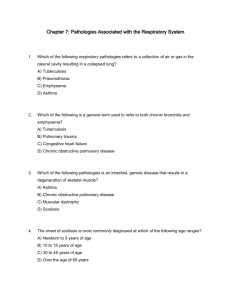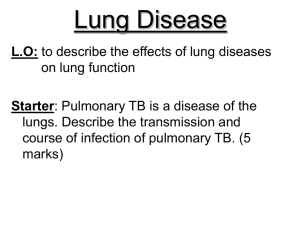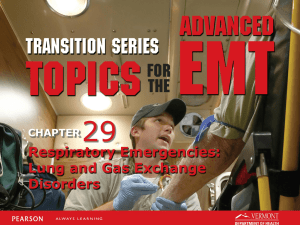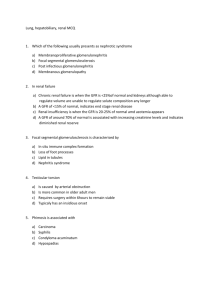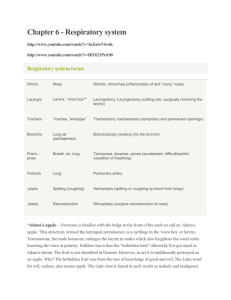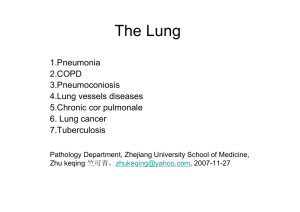Chapter 12 The Respiratory System-Dr. Alex
advertisement
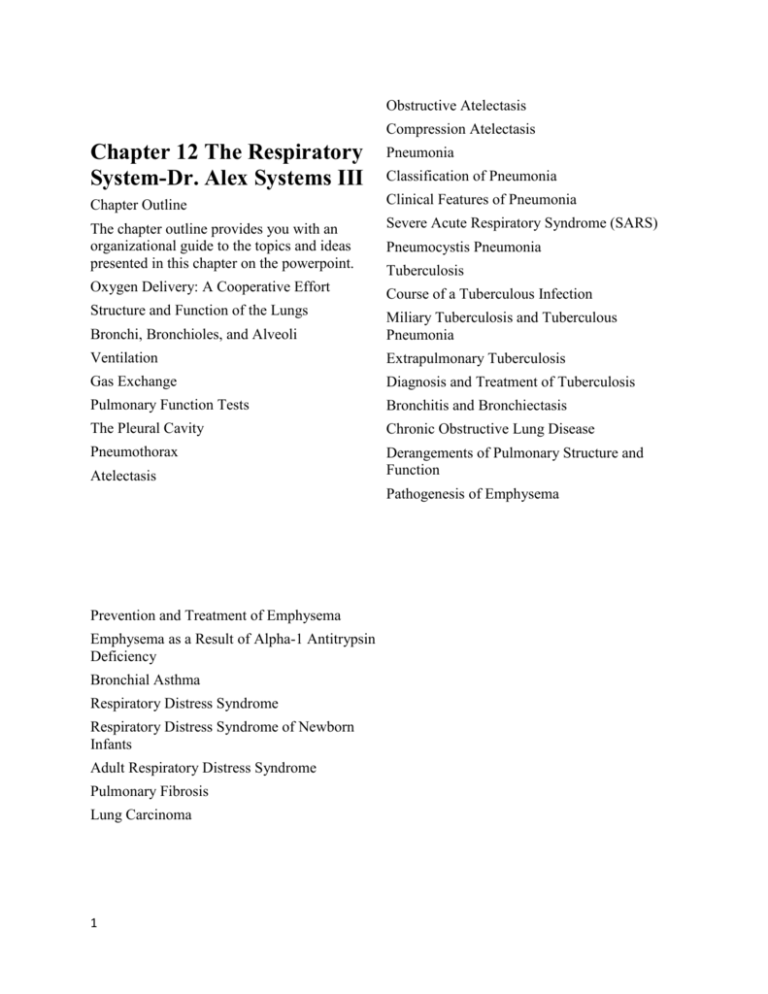
Obstructive Atelectasis Compression Atelectasis Chapter 12 The Respiratory System-Dr. Alex Systems III Pneumonia Chapter Outline Clinical Features of Pneumonia The chapter outline provides you with an organizational guide to the topics and ideas presented in this chapter on the powerpoint. Severe Acute Respiratory Syndrome (SARS) Oxygen Delivery: A Cooperative Effort Course of a Tuberculous Infection Structure and Function of the Lungs Bronchi, Bronchioles, and Alveoli Miliary Tuberculosis and Tuberculous Pneumonia Ventilation Extrapulmonary Tuberculosis Gas Exchange Diagnosis and Treatment of Tuberculosis Pulmonary Function Tests Bronchitis and Bronchiectasis The Pleural Cavity Chronic Obstructive Lung Disease Pneumothorax Derangements of Pulmonary Structure and Function Atelectasis Classification of Pneumonia Pneumocystis Pneumonia Tuberculosis Pathogenesis of Emphysema Prevention and Treatment of Emphysema Emphysema as a Result of Alpha-1 Antitrypsin Deficiency Bronchial Asthma Respiratory Distress Syndrome Respiratory Distress Syndrome of Newborn Infants Adult Respiratory Distress Syndrome Pulmonary Fibrosis Lung Carcinoma 1 Study Questions Key Terms (1-5) The following questions are provided as a test Define the following terms: for comprehension and as a study guide for use 1. Miliary tuberculosis with the PPT chapters. ______________________________________ _________ 2. Pulmonary fibrosis ______________________________________ _________ 3. Pneumothorax ______________________________________ _________ 4. Pulmonary emphysema ______________________________________ ____ 5. Pneumonia ______________________________________ _________ Fill-in-the-Blank (1-18) 5. The agent that causes severe acute respiratory syndrome (SARS) is _______________. 1. Movement of air in and out of the lungs is called _______________, and movement of oxygen and carbon dioxide between alveoli and pulmonary capillaries is called _______________. 6. Primary atypical pneumonia is caused by _______________. 2. Escape of air from the lung associated with collapse of the lung is called a _______________. 8. The skin test that detects hypersensitivity to the antigens in the tubercle bacillus as an indication of previous exposure to the organism is called the _______________test. 7. The characteristic multinucleated cell associated with the necrosis in tuberculosis is called a _______________. 3. Development of a positive (higher than 9. Deficiency of surfactant in the lungs of atmospheric) pressure in the pleural cavity associated with collapse of the lung is called a premature infants leads to a condition called _______________ and this condition is treated _______________. by_______________. 4. Collapse of part of the lung caused by obstruction of bronchi or bronchioles with absorption of the trapped air into the bloodstream is called _______________. 2 15. The incidence of pulmonary emphysema is _______________. 10. The condition characterized by breathing difficulty caused by bronchospasm is called _______________. 16. _______________is the major factor responsible for the rising incidence of lung carcinoma in women. 11. Progressive pulmonary fibrosis caused by inhalation of rock dust is called _______________. 17. _______________is a condition characterized by chronic inflammation with dilation of bronchi. 12. Pulmonary fibrosis caused by inhalation of 18. Inhalation of a foreign body in the lung may cause _______________. asbestos fibers is called _______________. 13. The disease caused by exposure to asbestos fibers may predispose a person to development of malignant lung and pleural tumors. The lung tumor is called a _______________, and the pleural tumor is called a _______________. 14. The disease characterized by chronic bronchitis associated with breakdown of alveolar septa, formation of cystic spaces throughout the lung, and loss of lung elasticity is called _______________. True/False (1-3) 1. Tell whether each statement is true or false 2. Tell whether each statement is true or false regarding the severe acute respiratory syndrome regarding the treatment of emphysema by lung (SARS). If false, explain why the statement is volume reduction surgery (LVRS). If false, explain why the statement is incorrect. incorrect. 1a. This highly communicable disease is caused 2a. LVRS may be suitable for some patients who by an unusual coronavirus. ______________ have emphysema restricted to the upper lobes of the lungs.________________ 1b. The virus can be transmitted by coughing and sneezing and by the virus-contaminated hands of an infected patient._______________________ 3 1c. The virus responds to antiviral antibiotics.___________ 2b. LVRS involves resecting segments of emphysematous upper lobes in an effort to 1d. The lungs of severely affected SARS patients reduce the size of the overinflated lungs so that the less severely affected lower lobes can develop features characteristic of adult function more efficiently.__________________ respiratory distress syndrome.______________________________ 2c. The mortality rate for medically treated _ patients with emphysema is similar to the mortality rate for surgically treated patients. ___________________ 2d. Surgical treatment is much more effective than medical treatment in almost all emphysema patients.____________ 3c. Lung volume reduction surgery is a very 3. Tell whether each statement is true or false. If effective treatment of severe pulmonary false, explain why the statement is incorrect. emphysema and provides long-term a. Infants born to mothers with diabetes are at increased risk of developing the neonatal respiratory distress syndrome.___________________ b. Infants delivered by cesarean section are at greater risk of neonatal respiratory distress syndrome than are infants delivered vaginally.______________________ improvement of the disease. ___________________ 3d. Immunocompromised persons who become infected with the tubercle bacillus (Mycobacterium tuberculosis) are at a greater risk of developing active progressive pulmonary tuberculosis than are persons with a normal immune system. ______________ 3e. Lung carcinoma is responsible for more deaths in women than breast carcinoma. ________ Identification (1) 1. List three conditions that appear to be related to cigarette smoking. a. ______________________________________ ____________ c. b. ______________________________________ ______________________________________ ____________ ____________ 4 Discussion Questions (1-15) 1. How do the lungs function? _______________________ 2. What is the difference between ventilation and gas exchange? _____ 3. How is pulmonary function disturbed if the alveolar septa are thickened and scarred? ______________________________________ _______________________ 4. How is pneumonia classified? What are its major clinical features? ____________ 8. What type of inflammation is caused by the tubercle bacillus? ____________ 5. How does the tubercle bacillus differ in its staining reaction from other bacteria? ____________ 6. What factors determine the outcome of a tuberculous infection? ________________ 9. A patient has tuberculosis of the kidney, but no evidence of pulmonary tuberculosis is detected by means of a chest x-ray. How did this happen? _________________ 10. What is meant by the term “inactive tuberculosis”? Under what circumstances may 7. How does a cavity develop in lungs infected an old, inactive tuberculous infection become with tuberculosis? Is a person with a tuberculous activated? What types of patients are susceptible cavity infectious to other people? _________ to reactivation of a tuberculous infection? ______________ 11. How does a pneumothorax occur? What is its effect on pulmonary function? ______________ 12. What factors predispose a person to the development of pulmonary emphysema? How may it be prevented? _________________ 14. A postoperative patient with a normal temperature has a pulmonary infiltrate, chest pain, and bloody sputum. What is the most likely diagnosis? ____________ 13. A 35-year-old man has a pulmonary infiltrate 15. What is the cause of interstitial pneumonia with chills, fever, chest pain, and purulent (primary atypical pneumonia)? ___________ sputum. What is the most likely diagnosis? _____________ 5

